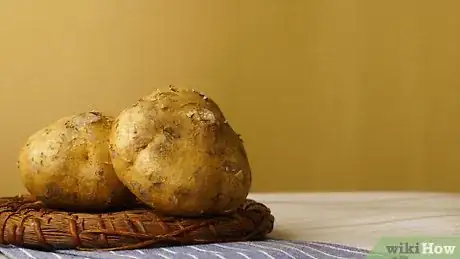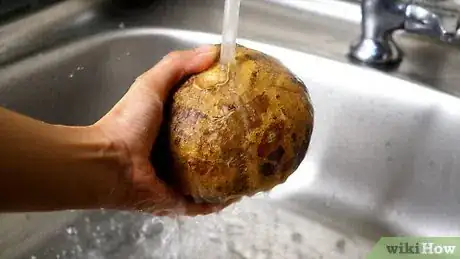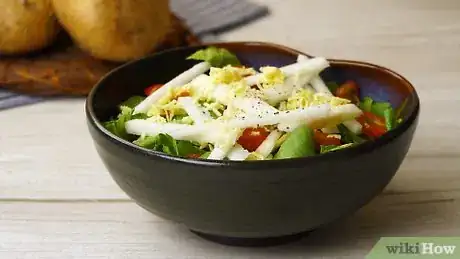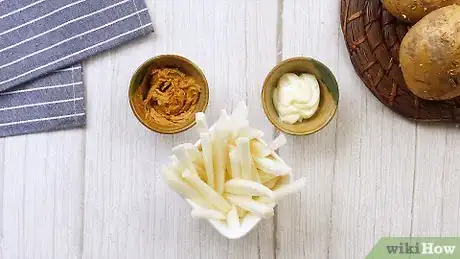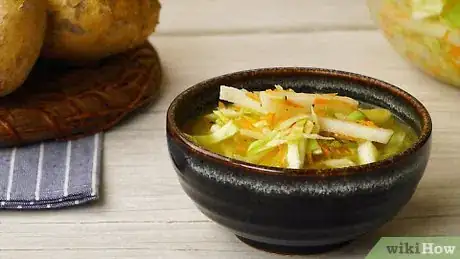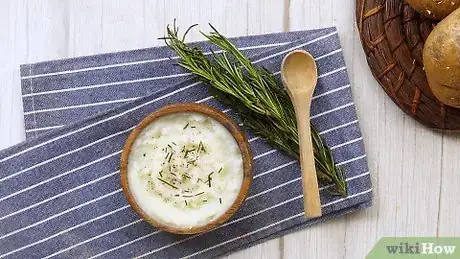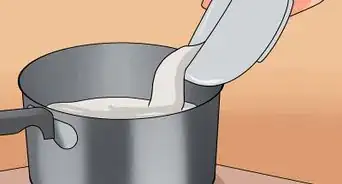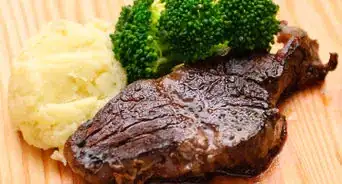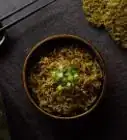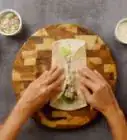This article was co-authored by Randall Chambers. Randall (Randy) Chambers is a Personal Chef and the Owner of Luxury Meals From Home based in Arvada, Colorado. He has more than 16 years of commercial kitchen experience, five years of sous chef experience, and two years of experience as an executive chef. Chef Randy draws inspiration from his half Bolivian background and his forte is South American cuisine. He holds an Associate’s degree in Culinary Arts from The Art Institute.
There are 12 references cited in this article, which can be found at the bottom of the page.
wikiHow marks an article as reader-approved once it receives enough positive feedback. This article received 22 testimonials and 100% of readers who voted found it helpful, earning it our reader-approved status.
This article has been viewed 404,838 times.
Jicama is a plant and vine that is indigenous to Mexico. Only the root of the plant is edible, and it resembles a large light-brown colored turnip. The white, creamy interior has a crisp texture somewhat similar to a pear or raw potato. Cooking jicama or serving it raw are equally tasty ways to prepare this lightly sweet root.
Steps
Choosing and Prepping Jicama Roots
-
1Choose a ripe jicama.[1] You can find jicama at Latin grocery stores, health food stores, and some mainstream supermarkets in the produce aisle. Look for a small or medium-sized jicama with brown skin. It should be slightly shiny, rather than dull. Choose a root without any blemishes or soft spots.
- The smaller jicama are younger and sweeter. If you want a starchier taste, choose a larger jicama, though it might be a bit woody in texture.
- The jicama should be heavy for its size. If it feels light, it has probably been sitting there for a long time, and the moisture has started to evaporate.
- Jicama are not seasonal, so you should be able to find a good selection all year round.
-
2Scrub the jicama. Use a vegetable scrubber or a clean cloth wet with water to scrub the skin of the jicama. The skin will be removed, since it isn't edible, but you want to clean off all the dirt before peeling.Advertisement
-
3Peel the jicama. It's easy to use a potato or carrot peeler to do the job. Peel all traces of the skin from the jicama, since ingesting the skin could give you a stomach ache.
-
4
-
5Keep the jicama fresh. If you don't immediately use the jicama, you can keep it fresh longer and avoid discoloration by submerging the processed jicama in a bowl of cold water with a squeeze of lemon juice. The citric acid in the juice will help keep the jicama in good shape for up to 2 days if you store it in the refrigerator.
Eating Raw Jicama
-
1Add jicama to your salad.[4] Jicama is a crunchy, flavorful, bright addition to any type of salad. Slice it into thin sticks or small cubes and simply toss it into your salad along with your other favorite mix-ins. Jicama pairs especially well with citrusy dressings.
- Raw jicama is great in fruit salads, dipped into salsa, lettuce-based salads, chicken salad, pasta salad, or just about any other application you can imagine.
-
2Make jicama slaw.[5] [6] This popular use for raw jicama is a great accompaniment to steak or fish. Slice a small jicama into small sticks, then toss it with the following ingredients to create a delicious slaw:
- 1/2 head of cabbage, chopped
- 1 large carrot, shredded
- 1/2 cup lime juice
- 2 tablespoons vinegar
- 1 tablespoon honey
- 1/2 cup grapeseed or canola oil
- Salt, pepper, and other spices to taste
-
3Make jicama chips.[7] If you have a particularly ripe, sweet jicama, a great way to serve it is in the form of chips. This makes a very healthy appetizer or side dish. Simply slice the jicama into thin, bite-sized discs. Arrange them in an attractive pattern on a serving platter and squeeze lime juice over the chips. Sprinkle with salt, pepper, and chili powder.
-
4Serve jicama with dip the same way you would carrots.[8]
Cooking With Jicama
-
1Roast a jicama. The flesh of a jicama is just as good cooked as it is raw. Roasting it makes it taste slightly sweeter. Try roasting a jicama in place of potatoes or sweet potatoes. To do so, use the following method:[9]
- Preheat the oven to 400 °F (204 °C).
- Peel and cube the jicama.
- Toss the cubes with 1/4 cup cooking oil, salt and pepper, and your favorite spices.
- Roast the jicama cubes for 15 minutes.
-
2Sauté a jicama.[10] Sauteed jicama makes for a unique and delectable side dish. Peel and cube a jicama, then heat some oil in a saucepan and Sauté the jicama until it turns golden brown. Season it with salt and pepper to taste.
-
3Make stir-fried jicama. Jicama is a great vegetable to substitute for water chestnuts or potatoes in a stir fry. Chop your jicama into bite-sized pieces, then add it to the frying pan with other cut vegetables like snow peas, carrots, and green beans. Dress the stir fry with soy sauce, rice wine vinegar, and sesame oil.
-
4Make stewed jicama. Jicama can be added to just about any soup or stew recipe. Cut the jicama into small cubes and add it to your favorite soup recipe, or toss it the cubes in near the end of a stew's cooking time.
-
5Make boiled and mashed jicama. Mashed jicama can be used as a substitute for mashed potatoes. Simply peel the jicama, then cube it and boil it in lightly salted water. Add a peeled and crushed garlic clove for extra flavor. Simmer the jicama until it is fork-tender, then drain it and mash it with a potato masher. Add butter and milk or cream and stir until the mash is light and fluffy.
Expert Q&A
-
QuestionDo you eat jicama raw or cooked?
 Randall ChambersRandall (Randy) Chambers is a Personal Chef and the Owner of Luxury Meals From Home based in Arvada, Colorado. He has more than 16 years of commercial kitchen experience, five years of sous chef experience, and two years of experience as an executive chef. Chef Randy draws inspiration from his half Bolivian background and his forte is South American cuisine. He holds an Associate’s degree in Culinary Arts from The Art Institute.
Randall ChambersRandall (Randy) Chambers is a Personal Chef and the Owner of Luxury Meals From Home based in Arvada, Colorado. He has more than 16 years of commercial kitchen experience, five years of sous chef experience, and two years of experience as an executive chef. Chef Randy draws inspiration from his half Bolivian background and his forte is South American cuisine. He holds an Associate’s degree in Culinary Arts from The Art Institute.
Personal Chef You can eat it either way! You can add raw jicama to your slaws and tacos, or you can slice it thinly and roll it up with fillings. Stews and curries are a great way to enjoy cooked jicama.
You can eat it either way! You can add raw jicama to your slaws and tacos, or you can slice it thinly and roll it up with fillings. Stews and curries are a great way to enjoy cooked jicama. -
QuestionIs mashed jicama healthier than regular mashed white potatoes?
 Community AnswerYes, mashed jicama is healthier.
Community AnswerYes, mashed jicama is healthier. -
QuestionCan I dehydrate it?
 Community AnswerYes. They make a product called JicaChips that are dehydrated jicama pieces. Very delicious!
Community AnswerYes. They make a product called JicaChips that are dehydrated jicama pieces. Very delicious!
References
- ↑ https://www.youtube.com/watch?v=MsXUV2mn1Yc
- ↑ https://www.thekitchn.com/jicama-most-exciting-vegetable-youre-not-eating-the-vegetable-butcher-220006
- ↑ Randall Chambers. Personal Chef. Expert Interview. 1 March 2022.
- ↑ https://www.simplyrecipes.com/recipes/jicama_salad/
- ↑ https://www.myrecipes.com/recipe/jicama-slaw
- ↑ Randall Chambers. Personal Chef. Expert Interview. 1 March 2022.
- ↑ https://www.foodnetwork.com/recipes/jicama-chips-recipe2-1917368
- ↑ https://youtu.be/aOIaTsQevvY?t=345
- ↑ https://www.geniuskitchen.com/recipe/roasted-jicama-36543
About This Article
If you want to cook with jicama, choose a ripe jicama by selecting one that is small or medium-sized, brown, and slightly shiny. Then, scrub, peel, and slice the jicama. If you like, add thin slices of jicama to your salad for some extra color and flavor. Alternatively, cut the jicama into discs, sprinkle them with lime juice, salt, and pepper, and serve them as chips. If you want to serve jicama with dip, cut them into thin sticks the same way you would with carrots. For tips on cooking with jicama, including how to roast a jicama, read on!
